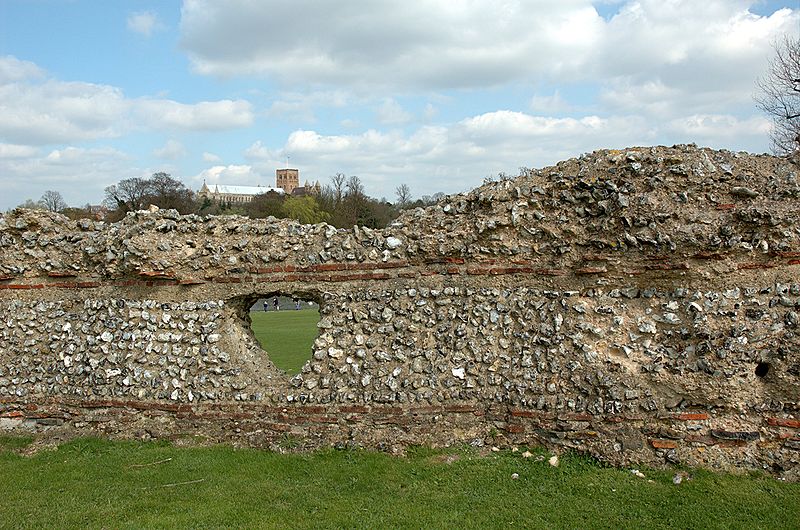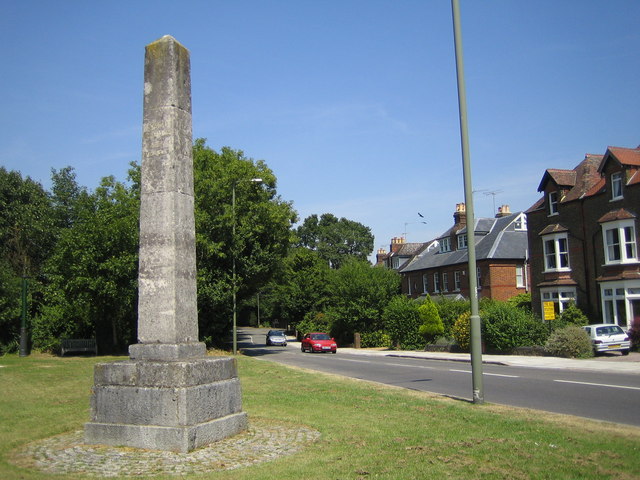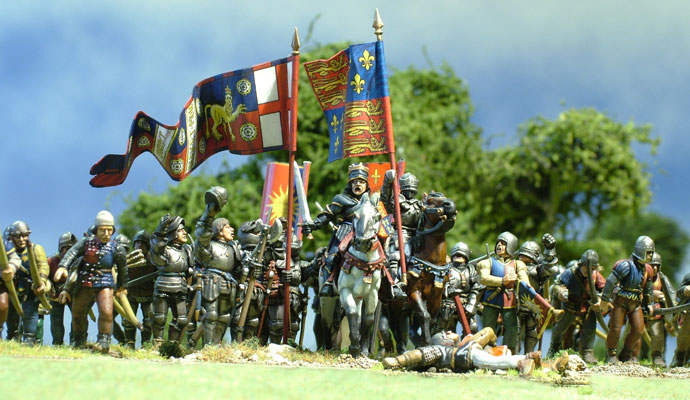 The kingdom was mostly ungoverned while the two factions gathered adherents and prepared for major warfare. Riots took place in the streets of London and trade
The kingdom was mostly ungoverned while the two factions gathered adherents and prepared for major warfare. Riots took place in the streets of London and trade --especially the valuable trade in wool with Holland--
--especially the valuable trade in wool with Holland-- The citizens of London, favouring the Yorkists, refused to contribute soldiers or money to the cause of defending against an invasion.
The citizens of London, favouring the Yorkists, refused to contribute soldiers or money to the cause of defending against an invasion. The Wars of the Roses were intermittent civil wars fought by members of the House of Lancaster and the House of York. Both houses were branches of the Plantagenet royal house, tracing their descent from King Edward III.
The Wars of the Roses were intermittent civil wars fought by members of the House of Lancaster and the House of York. Both houses were branches of the Plantagenet royal house, tracing their descent from King Edward III.
What was the cause of the Wars of the Roses?

The rivalry between the house of York and the House of Lancaster started when King Richard II was overthrown by his cousin, Henry Bolingbroke, Duke of Lancaster, in 1399. But the Wars of the Roses actually began on May 22, 1455 with First Battle of St Albans when Richard, Duke of York and his ally, Richard, Earl of Warwick defeated the Lancastrians under Edmund Beaufort who was killed. York captured Henry VI.The Lancastrian army of 2,000 troops arrived at St Albans first, and proceeded to defend it by placing troops along the Tonman Ditch
But the Wars of the Roses actually began on May 22, 1455 with First Battle of St Albans when Richard, Duke of York and his ally, Richard, Earl of Warwick defeated the Lancastrians under Edmund Beaufort who was killed. York captured Henry VI.The Lancastrian army of 2,000 troops arrived at St Albans first, and proceeded to defend it by placing troops along the Tonman Ditch  and at the bars in Sopwell Lane
and at the bars in Sopwell Lane
 and Shropshire Lane
and Shropshire Lane
. The 3,000-strong Yorkist army arrived and camped in Keyfield to the east. Lengthy negotiations ensued with heralds moving back and forth between the rival commanders
The 3,000-strong Yorkist army arrived and camped in Keyfield to the east. Lengthy negotiations ensued with heralds moving back and forth between the rival commanders
. After several hours, Richard, despairing of a peaceful solution, decided to attack. The bulk of Henry's forces were surprised by the speed of Richard's attack; most of the army was expecting a peaceful resolution similar to the one at Blackheath in 1452. However, two frontal assaults down the narrow streets against the barricades made no headway and resulted in heavy casualties for the Yorkists.below goat inn in sopwell lane as above
After several hours, Richard, despairing of a peaceful solution, decided to attack. The bulk of Henry's forces were surprised by the speed of Richard's attack; most of the army was expecting a peaceful resolution similar to the one at Blackheath in 1452. However, two frontal assaults down the narrow streets against the barricades made no headway and resulted in heavy casualties for the Yorkists.below goat inn in sopwell lane as above


The rivalry between the house of York and the House of Lancaster started when King Richard II was overthrown by his cousin, Henry Bolingbroke, Duke of Lancaster, in 1399.
 But the Wars of the Roses actually began on May 22, 1455 with First Battle of St Albans when Richard, Duke of York and his ally, Richard, Earl of Warwick defeated the Lancastrians under Edmund Beaufort who was killed. York captured Henry VI.The Lancastrian army of 2,000 troops arrived at St Albans first, and proceeded to defend it by placing troops along the Tonman Ditch
But the Wars of the Roses actually began on May 22, 1455 with First Battle of St Albans when Richard, Duke of York and his ally, Richard, Earl of Warwick defeated the Lancastrians under Edmund Beaufort who was killed. York captured Henry VI.The Lancastrian army of 2,000 troops arrived at St Albans first, and proceeded to defend it by placing troops along the Tonman Ditch  and Shropshire Lane
and Shropshire Lane.
 The 3,000-strong Yorkist army arrived and camped in Keyfield to the east. Lengthy negotiations ensued with heralds moving back and forth between the rival commanders
The 3,000-strong Yorkist army arrived and camped in Keyfield to the east. Lengthy negotiations ensued with heralds moving back and forth between the rival commanders.
 After several hours, Richard, despairing of a peaceful solution, decided to attack. The bulk of Henry's forces were surprised by the speed of Richard's attack; most of the army was expecting a peaceful resolution similar to the one at Blackheath in 1452. However, two frontal assaults down the narrow streets against the barricades made no headway and resulted in heavy casualties for the Yorkists.below goat inn in sopwell lane as above
After several hours, Richard, despairing of a peaceful solution, decided to attack. The bulk of Henry's forces were surprised by the speed of Richard's attack; most of the army was expecting a peaceful resolution similar to the one at Blackheath in 1452. However, two frontal assaults down the narrow streets against the barricades made no headway and resulted in heavy casualties for the Yorkists.below goat inn in sopwell lane as above
Warwick took his reserve troops through an unguarded part of the town's defences, through back lanes and gardens. Suddenly the Earl appeared in the Market Square where the main body of Henry's troops were talking and resting. There is evidence they were not yet expecting to be involved in the fighting, as many were not even wearing their helmets. Warwick charged instantly with his force, routing the Lancastrians and killing the Duke of Somerset.

On the Earl's orders, his archers then shot at the men around the King, killing several and injuring the King and the Duke of Buckingham. The Lancastrians manning the barricades realised the Yorkists had ouflanked them, and fearing an attack from behind abandoned their positions and fled the town.

The First Battle of St Albans was relatively minor in military terms, but politically was a complete victory for York and Warwick: York had captured the King and restored himself to complete power, while his rival Somerset and Warwick's arch-enemies Henry Percy, 2nd Earl of Northumberland, and Lord de Clifford both fell during the rout.

Shakespeare's history play Henry VI, Part 2 ends with the result of this battle
Why were they called the Wars of the Roses?

The White Rose was the symbol of Yorkist supporters who opposed the rival House of Lancaster, whose symbol was the Red Rose of Lancaster. The opposition of the two parties, symbolised by the red and white roses gave the wars their name - the Wars of the Roses. The Wars of the Roses ended with King Henry VII who started the Tudor dynasty and symbolically united the White and Red Roses to create the Tudor Rose.

The White Rose was the symbol of Yorkist supporters who opposed the rival House of Lancaster, whose symbol was the Red Rose of Lancaster. The opposition of the two parties, symbolised by the red and white roses gave the wars their name - the Wars of the Roses. The Wars of the Roses ended with King Henry VII who started the Tudor dynasty and symbolically united the White and Red Roses to create the Tudor Rose.
Wars of the Roses - The House of LancasterHouse of Lancaster
Henry IV ("Bolingbroke," son of the Duke of Lancaster), 1399-1413.
Henry V (son of Henry IV), 1413-1422.
Henry VI (son of Henry V, deposed), 1422-1471.
Henry IV ("Bolingbroke," son of the Duke of Lancaster), 1399-1413.

Henry V (son of Henry IV), 1413-1422.
Henry VI (son of Henry V, deposed), 1422-1471.
Wars of the Roses - The House of LancasterHouse of York:
Edward IV (son of duke of York), 1461-1483.
Edward V (son of Edward IV), 1483.
Richard III ("Crookback," brother of Edward IV) 1483-1485
Edward IV (son of duke of York), 1461-1483.
Edward V (son of Edward IV), 1483.
Richard III ("Crookback," brother of Edward IV) 1483-1485
Important Facts about the Wars of the Roses
Interesting information and important facts:

Interesting information and important facts:

- Key Dates relating to the event: The Wars of the Roses raged from 1455 - 1485
- Key People relating to the event: the Kings of England who were from the House of York and the House of Lancaster
- The Lancastrians were:
- Henry IV ("Bolingbroke," son of the Duke of Lancaster), 1399-1413
- Henry V (son of Henry IV), 1413-1422
- Henry VI (son of Henry V, deposed), 1422-1471
- The Yorkists were:
- Edward IV (son of duke of York), 1461-1483
- Edward V (son of Edward IV), 1483
- Richard III ("Crookback," brother of Edward IV) 1483-1485

Battles fought during the Wars of the Roses
The battles which were fought during the Wars of the Roses were:
The battles which were fought during the Wars of the Roses were:
1455: 
1460: Ba ttle of Northampton

1460: battle of wakefield

1471: Battle of Barnet

1471: Battle of Tewkesbury

1485: Battle of Bosworth Fiel


1460: Ba ttle of Northampton

1460: battle of wakefield

1471: Battle of Barnet

1471: Battle of Tewkesbury

1485: Battle of Bosworth Fiel

No comments:
Post a Comment